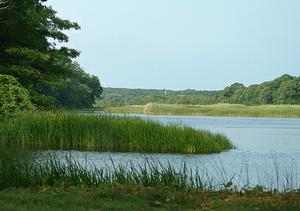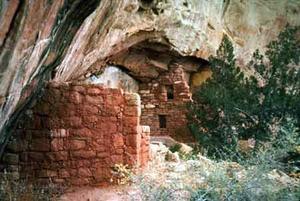Congress Votes 'Yes' to Sweeping Public Lands Protection Act
WASHINGTON, DC, March 25, 2009 (ENS) - Congress today approved a massive public lands bill that protects two million acres of wilderness in nine states and a thousand miles of rivers, a 50 percent increase in the wild and scenic river system. It establishes new national trails, national parks and a new national monument and provides legal status for the National Landscape Conservation System, which will protect some of the country's most spectacular landscapes.
 |
Wilson Arch south of Moab, Utah is under the jurisdiction of the Bureau of Land Management. (Photo courtesy BLM) |
The package of 164 separate bills bundled together, known as the Omnibus Public Lands Management Act of 2009 (H.R.146), has been stalled several times on its way to approval, most recently on March 11, when the measure fell two votes short of the two-thirds majority in the House required at that time.
Today, only a simple majority was required and the House passed the bill by a vote of 285 to 140. The bill was approved by the Senate last week and now goes to President Barack Obama for his signature into law. President Obama is expected to sign the measure.
House Speaker Nancy Pelosi said today is "a day of celebration for all who treasure and enjoy our natural and cultural heritage."
"This bipartisan legislation creates more than two million new acres of wilderness, and provides the greatest expansion of wilderness areas in 15 years, including more than 700,000 acres in my own state of California," Pelosi said.
"In this challenging time of drought in the West, the lands act also includes numerous water-related provisions that will help manage the drought, improve aging infrastructure, recharge groundwater supplies, and promote the reuse and recycling of water," Pelosi said. "The bill also contains a historic settlement to restore the San Joaquin River in the Central Valley of California."
"The provisions in this bill were developed in communities across America by local supporters, working together with their elected representatives," the speaker said. As a result, the bill enjoys broad support from wildlife, conservation, hunting and fishing, and outdoor business groups across the country."
 |
Taunton River at the Berkly Bridge, Massachusetts (Photo by Kenn Boostrom) |
Massachusetts lawmakers celebrated the Act for its protection of the Taunton River. Senator Ted Kennedy said, "Taunton River is an extraordinary part of our Commonwealth’s heritage and environment, and this national recognition is eminently deserved. The communities along the river watershed have worked hard for this designation, and they deserve great credit for this achievement."
"The Taunton River's natural beauty, important ecology and cultural heritage make it one of our state's most treasured natural resources. It is the longest coastal river in New England without dams, making it a haven for countless species of fish and other wildlife. The communities and associations have done a great job of maintaining and preserving the river over the years and now it will be permanently protected it for future generations," said Senator John Kerry.
Some Republicans object to the measure in part because it blocks energy development on public lands. Republican Study Committee Chairman Congressman Tom Price of Georgia said earlier this month that he and other conservative Repubicans oppose "the pork-filled package" because it would "block millions of acres for energy development, expand federal land holdings, give the government even more control over American land, and trample private property rights."
"It was a long and winding road to get this bill passed, but it was worth it to make sure that Mt. Hood and all the other special places in this bill are protected," said Oregon Senator Ron Wyden, a Democrat who authored seven of the bills in the package. "I'm glad Congress looked past politics and came together for our constituents, for the lands they love and for the jobs this bill will help create."
Conservationists are relieved and delighted that the legislation has finally leaped the Congressional hurdle.
"I am grateful that Congress has enacted this important legislation. Future generations will look back at this day as a major milestone in our nation's conservation history," said William Meadows, president of The Wilderness Society.
 |
Ancient Native American structures at Canyons of the Ancients National Monument (Photo courtesy BLM) |
The National Landscape Conservation System contains areas of archaeological and cultural significance including Canyons of the Ancients National Monument in southwest Colorado, and Agua Fria National Monument in Arizona as well as vast wild areas such as Nevada's Black Rock Desert National Conservation Area and California's King Range National Conservation Area.
The Conservation System protects critical habitat for fish and wildlife, provides access to world-class hunting and fishing, and offers challenging recreation for the self-guided adventurer, said Meadows.
"These places tell the story of America - and now, thanks to a concerted effort by many people, their future is more secure. That's good news for everybody," said Richard Moe, president of the National Trust for Historic Preservation.
"Even as a passionate supporter and regular visitor to our National Parks and Wilderness Areas, I was unaware that an enormous number of our nation's wildest and most historically significant public lands were outside this network, poorly managed and under threat," said Edward Norton, actor, conservationist, and National Conservation System Foundation Board Member.
"By permanently approving the National Landscape Conservation System, Congress has ensured that these irreplaceable natural treasures will receive the protection they deserve," Norton said.
The bill includes over 1,100 miles of 86 new Wild and Scenic Rivers in eight states, said David Moryc of the conservation group American Rivers. These rivers will remain free-flowing and will never be blocked by a dam.
 |
Amargosa River flows through Death Valley (Photo by Lindy Anna Jones) |
"Today, historic action has been taken to protect the Amargosa River," said David Lamfrom, California desert field representative with National Parks Conservation Assocation. "This ribbon of green amid one of the harshest environments on earth is now being recognized as a life-line for rare and endangered species, and as a critical source of water for Death Valley National Park and its gateway communities."
The measure authorizes the creation of the Ice Age Floods National Geologic Trail in the Pacific Northwest - the first national geologic trail in the National Park System.
The bill toughens penalties on the illegal collection of fossils on federal lands, including national parks such as Badlands in South Dakota and Petrified Forest in Arizona, ensuring that fossils from public lands are available for educational and scientific research.
Ocean protections are also contained in the package of legislation, said Laura Burton Capps, senior vice president for government affairs and communications with Ocean Conservancy.
The Ocean and Coastal Exploration and NOAA Act will authorize the National Ocean Exploration Program, National Undersea Research Program, and the Integrated Ocean and Coastal Mapping Program within the National Oceanic and Atmospheric Administration to increase scientific knowledge for the management, use and preservation of oceanic, coastal and Great Lake resources.
The Coastal and Ocean Observation System Act will authorize the establishment of an integrated system of coastal and ocean observations for the nation's coasts, oceans and Great Lakes.
The Federal Ocean Acidification Research and Monitoring Act will authorize a coordinated federal research program on ocean acidification.
The Coastal and Estuarine Land Protection Act will authorize funding for a program to protect important coastal and estuarine areas that have significant conservation, recreation, ecological, historical, aesthetic, or watershed protection values, and that are threatened by conversion to other uses.
"The ocean is 71 percent of our planet and our life support system, providing us with much of the oxygen we breathe, the food we eat and regulating the climate that we need to survive," said Capps. The leadership shown by Congress today will be reflected in the ocean we have to show our children and grandchildren."
Copyright Environment News Service (ENS) 2009. All rights reserved. To subscribe or visit go to: http://www.ens-newswire.com